Human–Wild Boar Coexistence: A Role-Playing Game for Collective Learning and Conflict Mitigation
Abstract
1. Introduction
2. Case Studies, Theoretical Framework and Methods
2.1. Case Studies
2.2. Theoretical Framework and Methods
2.2.1. A Role-Playing Game as an Intermediary Object
- Better understand the behaviour and movements of wild boars by giving a voice to local experts and people who have studied or interacted with wild boars;
- Discuss hunting in particular and its impact on wild boars themselves (in terms of behaviour, movement, population dynamics), humans and landscape sharing;
- Bring up for discussion issues that have been less studied or that may be controversial and difficult to discuss by other means, such as supplementary feeding.
- Discuss local situations in different contexts despite being a generic device;
- Allow us to gather different stakeholders with different areas of expertise, interests and standpoints in the human–wild boar network in a safe and playful atmosphere, thus contributing to (i) a better understanding of wild bar behaviour and movement and (ii) conflict mitigation.
2.2.2. Human and Non-Human Roles
2.3. Game Design
2.3.1. The Landscape
2.3.2. The Roles
2.3.3. The Biological Module: A Simplified Model of Wild Boar Population Dynamics
2.4. Setting up the Game
3. Results
3.1. Game Implementation
3.2. Knowledge Elicitation and Sharing
PA3: He’s making his population grow in the non-hunted area, we have to act, we have to do something.
PC3: It’s the military camp.
PW3: That’s right, it’s the military camp.
PC3: There are snake eagles over there, we can’t hunt or the ecologists are gonna come down on us.
PB3: Anyway, if it’s the military camp, you can’t hunt as you want […]. It’s not quite the military camp though because hunting is not forbidden in the military camp.
PB3: I use supplementary feeding but I’m keeping it for myself because we’re not allowed to normally. I mean we’re not allowed unless we have a special authorization from the department [i.e., district level].
PC3: Yes, but nobody checks.
PB3: Those who ask for an authorization, they get controlled. They’ve told where they put the grains, so they get controlled. The others they don’t say anything about where they put the grains, so they don’t get controlled.
PA3: So, it’s the ones who do things properly that get controlled…
GS [to PW2]: Have you considered supplementary feeding?
PW2: Absolutely not, never. No because I didn’t feel like I needed it.
PB2: Of course you do. In my opinion, wild boars, when there’s a protected area with hunting grounds in the neighbourhood, they preferably go where there’s supplementary feeding, whether it’s diversionary or… It depends on the environment but in similar conditions…
PA2: In the Bouches-du-Rhône, the problem is some people deviate because there’s no regulation on supplementary feeding for small game […].
PB2: Of course, a wild boar doesn’t feed on corn only, he’s gonna go for wheat too.
PC3: I wanna make money, and so have lots of wild boars, but mostly I wanna know the tricks of the trade, I wanna know how I can have lots of wild boars.
PB3: There aren’t any tricks of the trade for that.

PW3: On the military camp, we really don’t mind supplementary feeding, well, containing wild boars on the camp.
GS: With diversionary feeding?
PW3: Yes, that’s what the department allows. But we told them we could do more than that. We don’t have damage, there’s no risk for our vehicle—they weigh 30 tons—we have few buildings.
PA3: But there’s also the biodiversity. It may have no impact on the military activity, but maybe for biodiversity, if they dig and turn the soil upside down…
PW3: Yeah, I hadn’t thought about that…
3.3. Hunting Practices: Effort Levels and Efficiency
PA2: Each hunting type has its pros and cons and also an influence on the way your population is gonna react.
GS: So, what would have changed if we had included stalking?
PA2: Well then you can lower your hunting effort even more. For example, if you wanna make your population go up, you go stalking and make selective shots […]. To go back to hunting efficiency, if you include stalking, you’re not gonna have the same hunting efficiency and the same impact on your population compared to drive hunts where the biggest impact is gonna be in terms of disturbance.
PC2: With different types of hunting, you don’t kill the same individuals. The ones that escaped the drive hunt, well you can get them by stalking.
4. Discussion
4.1. Facilitating and Implementing the Game
4.2. WILD BOAR(D) GAME: An Adaptable Game to Address Constantly Evolving Practices and (Other-Than) Behaviours
4.3. Learning Processes and Conflict Mitigation Opportunities
4.4. Taking the Wild Boar’s Perspective
5. Conclusions
Author Contributions
Funding
Informed Consent Statement
Acknowledgments
Conflicts of Interest
References
- Massei, G.; Kindberg, J.; Licoppe, A.; Dragan, G.; Sprem, N.; Kamler, J.; Baubet, E.; Hohmann, U.; Monaco, A.; Ozolins, J.; et al. Wild Boar Populations up, Numbers of Hunters down? A Review of Trends and Implications for Europe. Pest Manag. Sci. 2014, 71, 492–500. [Google Scholar] [CrossRef] [PubMed]
- Etienne, C. Le Sanglier: Rencontres Privilégiées avec la Bête Noire; Biotope: Mèze, France, 2015. [Google Scholar]
- Gigounoux, A. Le Sanglier et Les Politiques Publiques. Chasses-Chasseurs-Positionnements et Représentations Symboliques. Rev. For. Fr. 2019, 71, 393–408. [Google Scholar] [CrossRef]
- Ballari, S.A.; Barrios-García, M.N. A Review of Wild Boar Sus Scrofa Diet and Factors Affecting Food Selection in Native and Introduced Ranges. Mammal Rev. 2014, 44, 124–134. [Google Scholar] [CrossRef]
- Mounet, C. Conflits et reconfigurations socio-spatiales autour du sanglier. Des postures générales aux arrangements locaux. Écon. Rural. 2012, 327-328, 79–95. [Google Scholar] [CrossRef]
- Barrios-Garcia, M.N.; Ballari, S.A. Impact of Wild Boar (Sus Scrofa) in Its Introduced and Native Range: A Review. Biol. Invasions 2012, 14, 2283–2300. [Google Scholar] [CrossRef]
- Cardoux, J.-N.; Perea, A. Restaurer l’équilibre Agro-Sylvo-Cynégétique Pour Une Pleine Maîtrise Des Populations de Grand Gibier et de Leurs Dégâts à L’échelle Nationale; Mission Parlementaire Relative à la Régulation des Populations de Grand Gibier et à la Réduction de Leurs Dégâts; Sénat et Assemblée Nationale: Paris, France, 2019. [Google Scholar]
- Mathevet, R.; Bondon, R. Sangliers, Géographies d’un Animal Politique; Mondes Sauvages; Actes Sud: Arles, France, 2022. [Google Scholar]
- Massei, G.; Roi, S.; Bunting, R. Too Many Hogs? A Review of Methods to Mitigate Impact by Wild Boar and Feral Hogs. Hum.-Wildl. Interact. 2011, 5, 79–99. [Google Scholar]
- Maillard, D. Approche du fonctionnement de la population de sangliers (Sus scrofa L.) de la Réserve Naturelle de Roque-Haute à partir des résultats scientifiques obtenus sur l’espèce en milieu méditerranéen. Ecol. Mediterr. 1998, 24, 223–233. [Google Scholar] [CrossRef]
- Tolon, V.; Baubet, E. L’effet des réserves sur l’occupation de l’espace par le sanglier. Faune Sauvag. 2010, 288, 14–18. [Google Scholar]
- Colomer, J.; Rosell, C.; Rodriguez-Teijeiro, J.D.; Massei, G. ‘Reserve Effect’: An Opportunity to Mitigate Human-Wild Boar Conflicts. Sci. Total Environ. 2021, 795, 148721. [Google Scholar] [CrossRef]
- Morelle, K.; Podgórski, T.; Prévot, C.; Keuling, O.; Lehaire, F.; Lejeune, P. Towards Understanding Wild Boar Sus Scrofa Movement: A Synthetic Movement Ecology Approach. Mammal Rev. 2015, 45, 15–29. [Google Scholar] [CrossRef]
- Saïd, S.; Tolon, V.; Brandt, S.; Baubet, E. Sex Effect on Habitat Selection in Response to Hunting Disturbance: The Study of Wild Boar. Eur. J. Wildl. Res. 2012, 58, 107–115. [Google Scholar] [CrossRef]
- Thurfjell, H.; Spong, G.; Ericsson, G. Effects of Hunting on Wild Boar Sus scrofa Behaviour. Wildl. Biol. 2013, 19, 87–93. [Google Scholar] [CrossRef] [PubMed]
- Brivio, F.; Grignolio, S.; Brogi, R.; Benazzi, M.; Bertolucci, C.; Apollonio, M. An Analysis of Intrinsic and Extrinsic Factors Affecting the Activity of a Nocturnal Species: The Wild Boar. Mamm. Biol. 2017, 84, 73–81. [Google Scholar] [CrossRef]
- Vourch, A.; Pelosse, V. Chasser en Cévennes. Un Jeu Avec L’animal; Editions du CNRS: Paris, France, 1988. [Google Scholar]
- von Essen, E. How Wild Boar Hunting Is Becoming a Battleground. Leis. Sci. 2020, 42, 552–569. [Google Scholar] [CrossRef]
- Baubet, É. Alimentation Naturelle Ou Artificielle: Quels Effets Sur La Dynamique de Populations de Sanglier? ONCFS: Reims, France, 2008; pp. 120–128. [Google Scholar]
- Vajas, P.; Von Essen, E.; Tickle, L.; Gamelon, M. Meeting the Challenges of Wild Boar Hunting in a Modern Society: The Case of France. Ambio 2023, 52, 1359–1372. [Google Scholar] [CrossRef]
- Brogi, R.; Brivio, F.; Bertolucci, C.; Benazzi, M.; Luccarini, S.; Cappai, N.; Bottero, E.; Pedrazzoli, C.; Columbano, N.; Apollonio, M.; et al. Capture Effects in Wild Boar: A Multifaceted Behavioural Investigation. Wildl. Biol. 2019, 2019, wlb.00497. [Google Scholar] [CrossRef]
- Mermet, L. Une Méthode de Prospective: Les Exercices de Simulation de Politiques. Nat. Sci. Soc. 1993, 1, 34–46. [Google Scholar] [CrossRef]
- Janssen, M.A. Complexity and Ecosystem Management; Ed. Edward Elgar: Cheltenham, UK; Northhampton, MA, USA, 2002. [Google Scholar]
- Bousquet, F.; Le Page, C. Multi-Agent Simulations and Ecosystem Management: A Review. Ecol. Model. 2004, 176, 313–332. [Google Scholar] [CrossRef]
- Perrotton, A.; de Garine-Wichatitsky, M.; Valls-Fox, H.; Le Page, C. My Cattle and Your Park: Codesigning a Role-Playing Game with Rural Communities to Promote Multistakeholder Dialogue at the Edge of Protected Areas. Ecol. Soc. 2017, 22, 32. [Google Scholar] [CrossRef]
- Barreteau, O.; Abrami, G.; Bonté, B.; Bousquet, F.; Mathevet, R. Serious Games. In The Routledge Handbook of Research Methods for Social-Ecological Systems; Biggs, R., De Vos, A., Preiser, R., Clements, H., Maciejewski, K., Schluter, M., Eds.; Routledge, Taylor & Francis Group: London, UK, 2021; pp. 176–188. [Google Scholar]
- Etienne, M. (Ed.) Companion Modelling. A Participatory Approach to Support Sustainable Development; Springer: Dordrecht, The Netherlands, 2016. [Google Scholar]
- Edmonds, B.; Meyer, R. Simulating Social Complexity: A Handbook; Springer: Berlin/Heidelberg, Germany, 2013; ISBN 978-3-540-93813-2. [Google Scholar]
- Rodela, R.; Speelman, E.N. Serious games in natural resource management: Steps toward assessment of their contextualized impacts. Curr. Opin. Environ. Sustain. 2023, 65, 101375. [Google Scholar] [CrossRef]
- Vinck, D. Les objets intermédiaires dans les réseaux de coopération scientifique. Contribution à la prise en compte des objets dans les dynamiques sociales. Rev. Fr. Sociol. 1999, 40, 385–414. [Google Scholar] [CrossRef]
- Wolch, J.; Emel, J. Bringing the animals back in. Environ. Plan. D Soc. Space 1995, 13, 632–636. [Google Scholar]
- Philo, C.; Wilbert, C. Animal spaces, beastly places. An introduction. In Animal Spaces, Beastly Places: New Geographies of Human-Animal Relations; Routledge: London, UK, 2000. [Google Scholar]
- Lorimer, J.; Hodgetts, T.; Barua, M. Animals’ Atmospheres. Prog. Hum. Geogr. 2019, 43, 26–45. [Google Scholar] [CrossRef]
- Plumwood, V. Environmental Culture: The Ecological Crisis of Reason; Environmental Philosophies; Routledge: New York, NY, USA, 2001. [Google Scholar]
- Pelosse, V. Construction de l’animal cynégétique. Mouflons et sangliers en Languedoc. Études Rural. 1993, 129, 73–82. [Google Scholar] [CrossRef]
- Mathevet, R.; Le Page, C.; Etienne, M.; Lefebvre, G.; Poulin, B.; Gigot, G.; Proréol, S.; Mauchamp, A. BUTORSTAR: A Role-Playing Game for Collective Awareness of Wise Reedbed Use. Simul. Gaming 2007, 38, 233–262. [Google Scholar] [CrossRef]
- Sargent, R.; Rakotonarivo, O.S.; Rushton, S.P.; Cascio, B.; Grau, A.; Bell, A.R.; Bunnefeld, N.; Dickman, A.; Pfeifer, M. An Experimental Game to Examine Pastoralists’ Preferences for Human–Lion Coexistence Strategies. People Nat. 2022, 4, 1263–1278. [Google Scholar] [CrossRef]
- Moreau, C.; Barnaud, C.; Mathevet, R. Conciliate Agriculture with Landscape and Biodiversity Conservation: A Role-Playing Game to Explore Trade-Offs among Ecosystem Services through Social Learning. Sustainability 2019, 11, 310. [Google Scholar] [CrossRef]
- Mathevet, R.; Hémery, G.; Gauthier-Clerc, M.; Mondain-Monval, J.Y.; Guillemain, M. Penser Comme un Canard dans la Réserve de Biosphère de Camargue: L’expérience ARTEMIS, A Computer-Based Role-Playing Game for Adaptive Hunting of Wild Duck Populations. In Proceedings of the Conference «Gestion et Conservation de la Biodiversité: Science et Action», Florac, France, 18–21 September 2007; Oral Comm. and Working Paper. SupAgro: Florac, France, 2007. [Google Scholar]
- Gamelon, M.; Touzot, L.; Baubet, E.; Cachelou, J.; Focardi, S.; Franzetti, B.; Nivois, E.; Veylit, L.; Sæther, B.-E. Effects of pulsed resources on the dynamics of seed consumer populations: A comparative demographic study in wild boar. Ecosphere 2021, 12, e03395. [Google Scholar] [CrossRef]
- Touzot, L.; Schermer, E.; Venner, S.; Delzon, S.; Rousset, C.; Baubet, E.; Gaillard, J.-M.; Gamelon, M. How Does Increasing Mast Seeding Frequency Affect Population Dynamics of Seed Consumers? Wild Boar as a Case Study. Ecol. Appl. 2020, 30, e02134. [Google Scholar] [CrossRef]
- Bayeck, R.Y. Examining board gameplay and learning: A multidisciplinary review of recent research. Simul. Gaming 2020, 51, 411–431. [Google Scholar] [CrossRef]
- Schéma Départemental de Gestion Cynégétique 2019–2025; Fédération Départementale des Chasseurs du Gard: Nîmes, France, 2019.
- Vajas, P. Évaluation Des Facteurs Influençant Le Succès de La Chasse Pour Gérer Le Sanglier (Sus Scrofa): Comprendre Les Relations Entre l’effort de Chasse, La Capturabilité et Les Conditions de Chasse. Ph.D. Thesis, University of Montpellier, Montpellier, France, 2020. [Google Scholar]
- Redpath, S.M.; Keane, A.; Andrén, H.; Baynham-Herd, Z.; Bunnefeld, N.; Duthie, A.B.; Frank, J.; Garcia, C.A.; Månsson, J.; Nilsson, L.; et al. Games as Tools to Address Conservation Conflicts. Trends Ecol. Evol. 2018, 33, 415–426. [Google Scholar] [CrossRef] [PubMed]
- Cahill, S.; Llimona, F.; Cabañeros, L.; Calomardo, F. Characteristics of Wild Boar (Sus scrofa) Habituation to Urban Areas in the Collserola Natural Park (Barcelona) and Comparison with Other Locations. Anim. Biodivers. Conserv. 2012, 35, 221–233. [Google Scholar] [CrossRef]
- Stillfried, M.; Gras, P.; Börner, K.; Göritz, F.; Painer, J.; Röllig, K.; Wenzler, M.; Hofer, H.; Ortmann, S.; Kramer-Schadt, S. Secrets of Success in a Landscape of Fear: Urban Wild Boar Adjust Risk Perception and Tolerate Disturbance. Front. Ecol. Evol. 2017, 5, 157. [Google Scholar] [CrossRef]
- Wang, Y.; Mumby, H. Differences in Reporting Human-Wild Boar Interactions in Chinese and English News Media. Hum. Dimens. Wildl. 2023, 28, 295–310. [Google Scholar] [CrossRef]
- Reed, M.S. Stakeholder Participation for Environmental Management: A Literature Review. Biol. Conserv. 2008, 141, 2417–2431. [Google Scholar] [CrossRef]
- Honda, T.; Iijima, H. Managing Boldness of Wildlife: An Ethological Approach to Reducing Crop Damage. Popul. Ecol. 2016, 58, 385–393. [Google Scholar] [CrossRef]
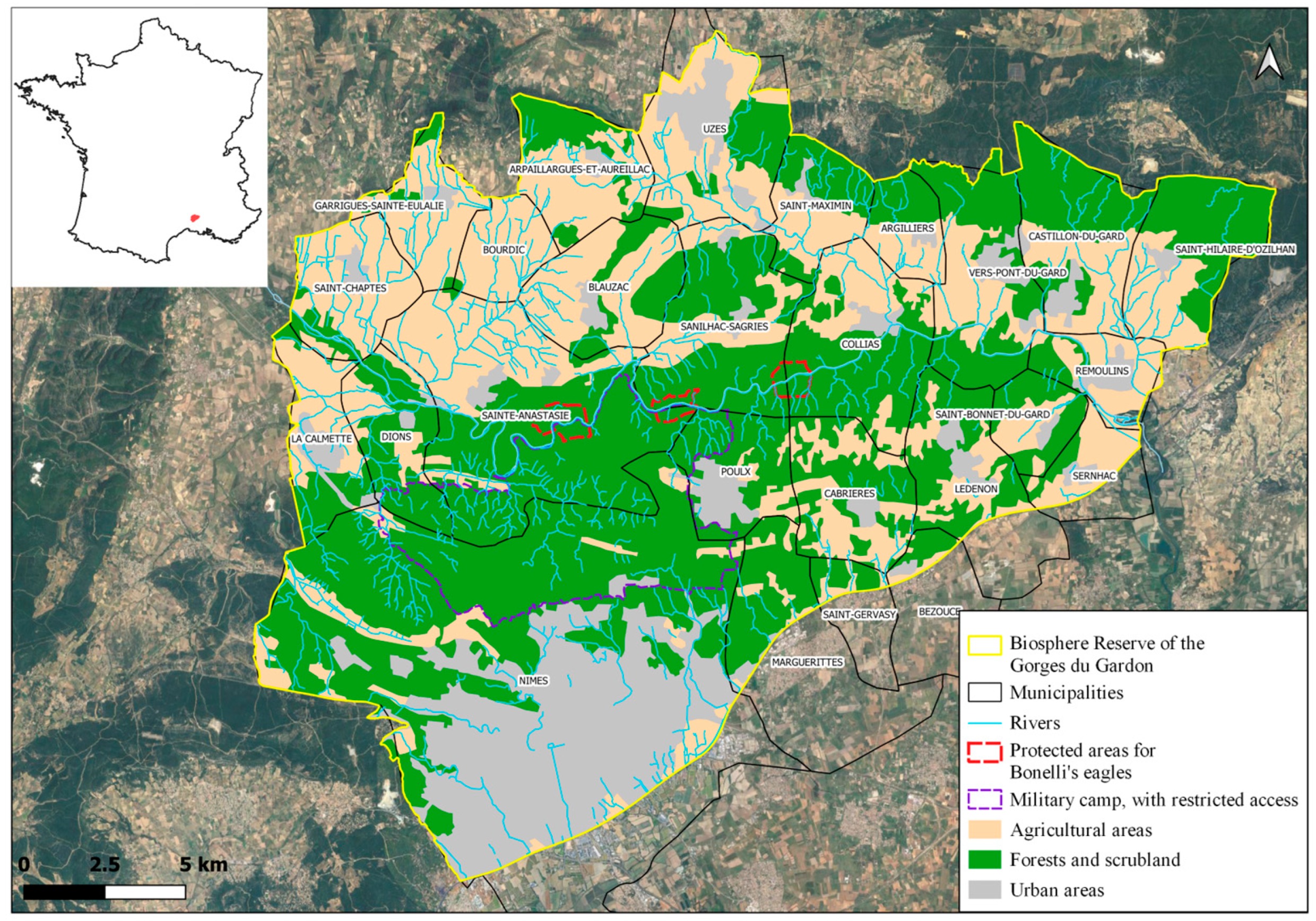
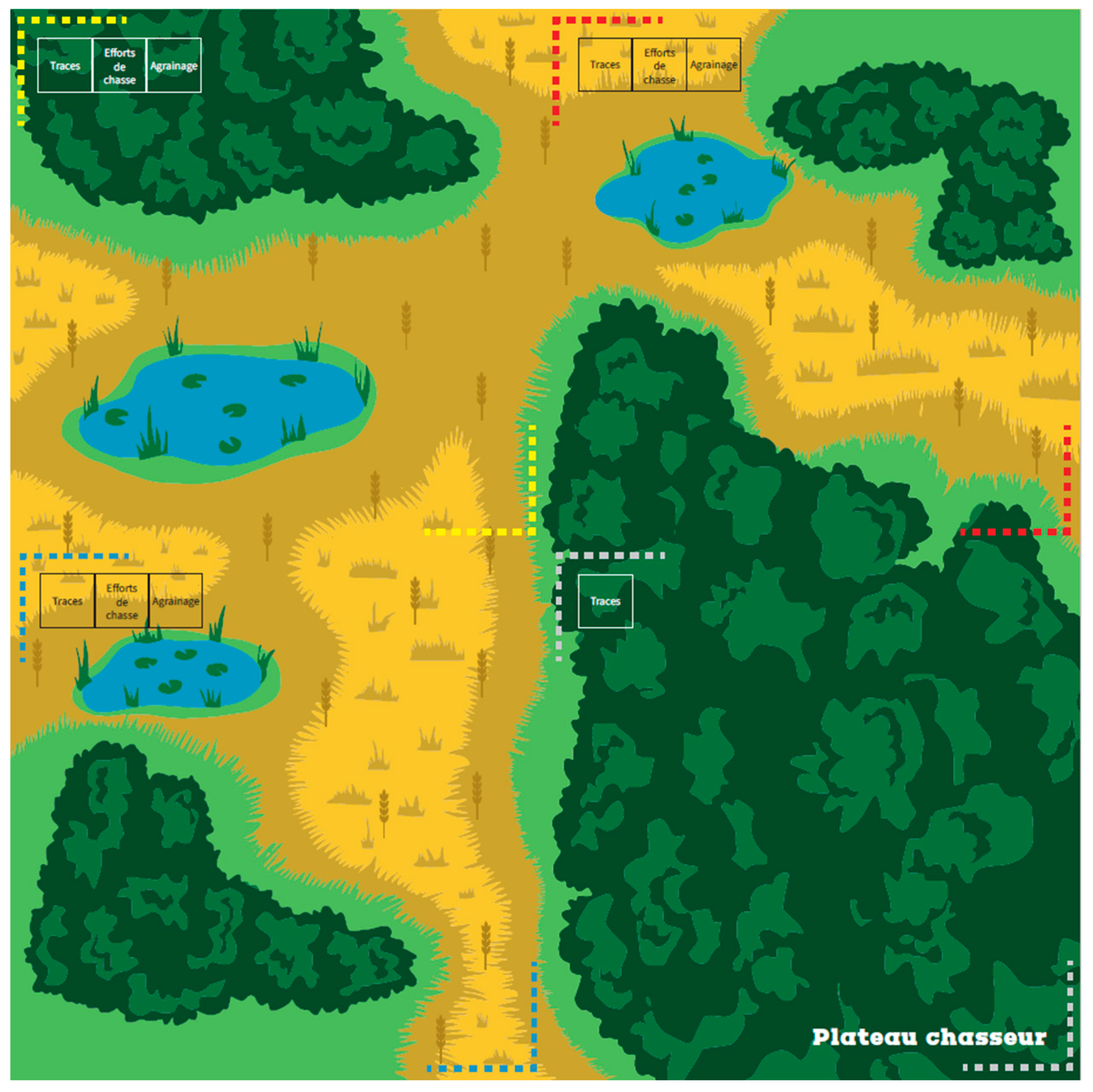
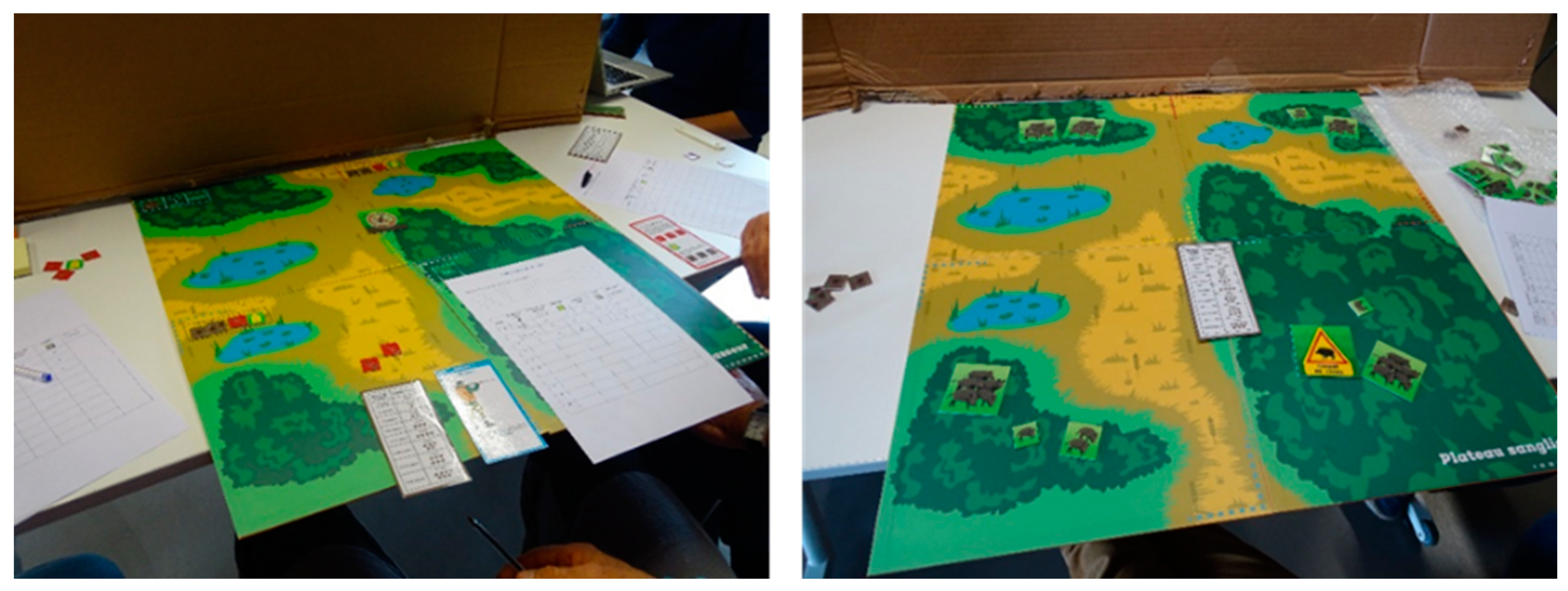
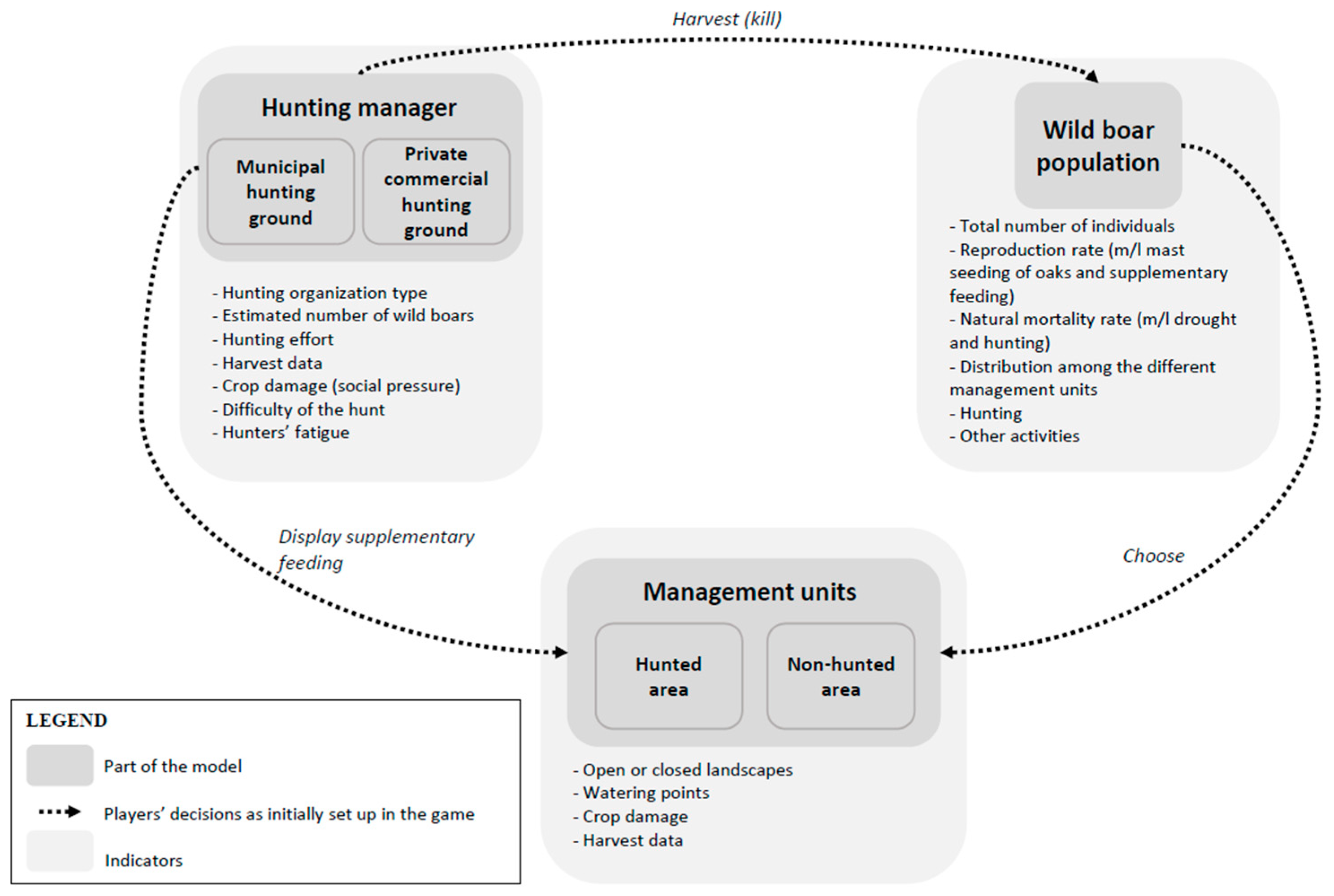

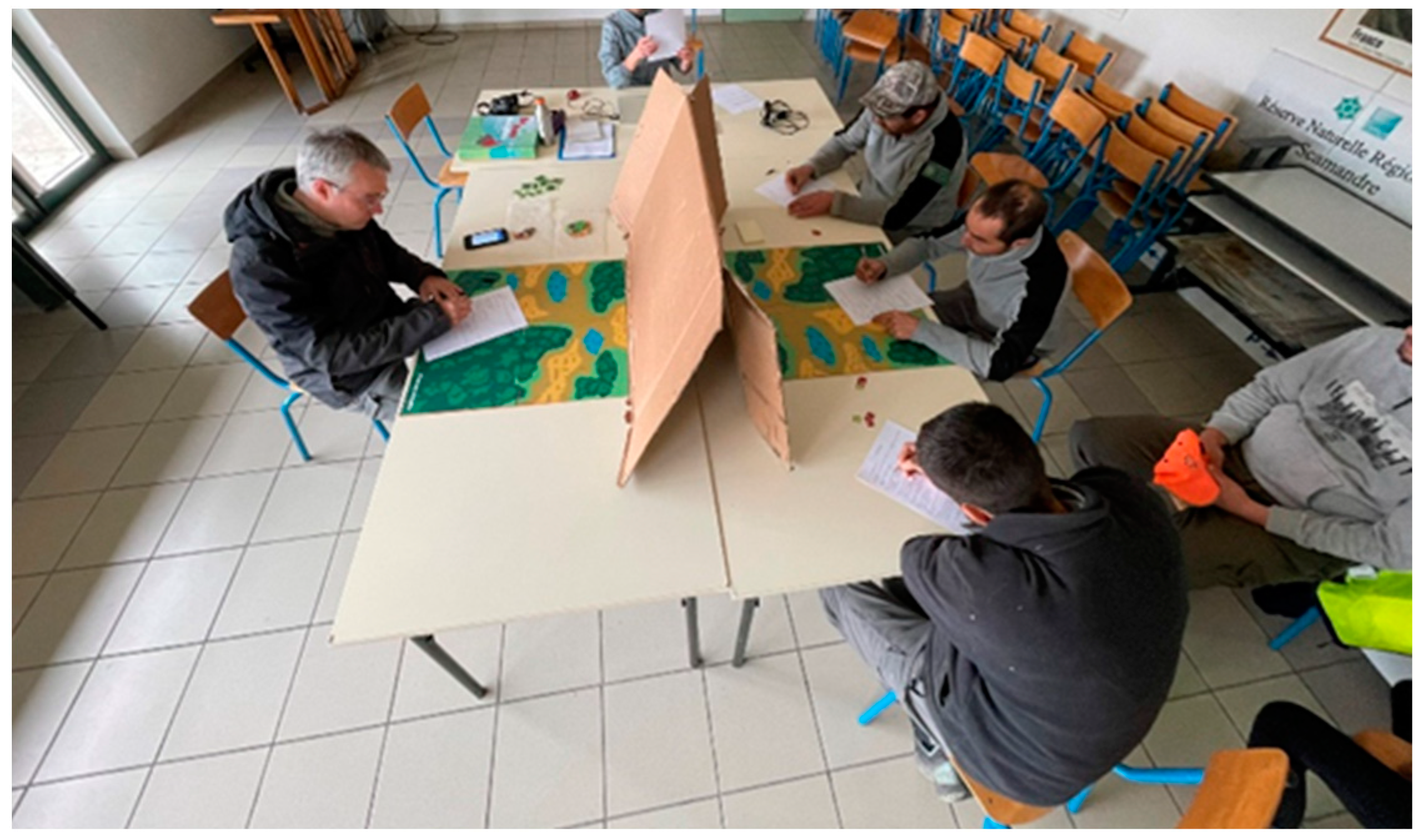
| Step | Details |
|---|---|
| 1 | The game supervisor specifies (if necessary) the characteristics of the round (important mast seeding of oaks, drought, special event). |
| 2 | The wild boar player
|
| 3 | The hunting managers decide
|
| 4 | The game supervisor, who has updated the different indicators, can now inform the players (hunting bags, crop damage, hunters’ fatigue, regulation drive hunt). |
Disclaimer/Publisher’s Note: The statements, opinions and data contained in all publications are solely those of the individual author(s) and contributor(s) and not of MDPI and/or the editor(s). MDPI and/or the editor(s) disclaim responsibility for any injury to people or property resulting from any ideas, methods, instructions or products referred to in the content. |
© 2024 by the authors. Licensee MDPI, Basel, Switzerland. This article is an open access article distributed under the terms and conditions of the Creative Commons Attribution (CC BY) license (https://creativecommons.org/licenses/by/4.0/).
Share and Cite
Coz, D.; Mathevet, R. Human–Wild Boar Coexistence: A Role-Playing Game for Collective Learning and Conflict Mitigation. Sustainability 2024, 16, 3551. https://doi.org/10.3390/su16093551
Coz D, Mathevet R. Human–Wild Boar Coexistence: A Role-Playing Game for Collective Learning and Conflict Mitigation. Sustainability. 2024; 16(9):3551. https://doi.org/10.3390/su16093551
Chicago/Turabian StyleCoz, Deborah, and Raphaël Mathevet. 2024. "Human–Wild Boar Coexistence: A Role-Playing Game for Collective Learning and Conflict Mitigation" Sustainability 16, no. 9: 3551. https://doi.org/10.3390/su16093551
APA StyleCoz, D., & Mathevet, R. (2024). Human–Wild Boar Coexistence: A Role-Playing Game for Collective Learning and Conflict Mitigation. Sustainability, 16(9), 3551. https://doi.org/10.3390/su16093551






